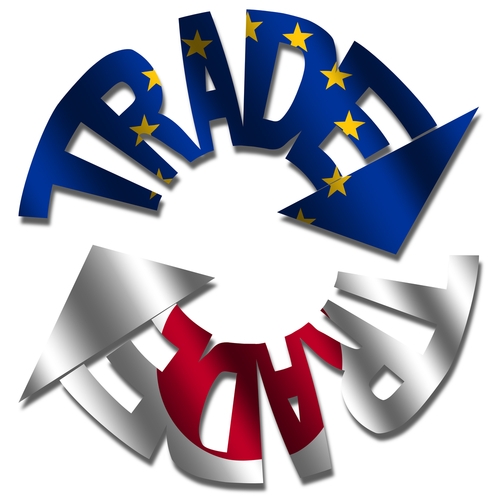| 6 language versions availableHandelsverhandlungen der EU mit Japan
Negociaciones comerciales entre la UE y Japón Négociations commerciales de l’Union européenne avec le Japon |
A “scoping exercise” by the European Commission and Japanese government on a possible free trade agreement was concluded on 31 May 2012. The Commission subsequently recommended to the Council that it authorise the opening of negotiations.
The EU and Japan are important trading partners, representing more than a third of the world’s GDP. The first bilateral Joint Declaration on Japan-EU trade dates back to 1991. Since then, although EU exports to Japan have been growing, the EU has lost share in the local market. On the other hand, Japan is trying to open its market to external competition, and an ambitious free trade agreement (FTA) could contribute to this objective. A successful FTA would have an impact on exports, jobs, competitiveness and growth, according to the Commission’s impact assessment. Trade liberalisation is seen as the cheapest way to stimulate economy in a geographical area where it is important to gain market access.
Non-tariff measures, because of the closed nature of the Japanese economy, would be the most difficult aspect to be tackled by an FTA. They include access to public procurement, mutual recognition and harmonisation of standards. Tokyo is addressing these concerns by revising internal regulations and promising further reforms. However, the European Union is calling for more ambitious provisions in the field of government procurement, investment possibilities, and the fields of chemicals, motor vehicles, pharmaceuticals and agriculture. The Japanese authorities aim to close the gap with South Korea in the European automotive and electronics markets, as Tokyo has recently lost market share with the EU-South Korea FTA coming into force.
The envisaged FTA would aim at eliminating tariffs, especially in sensitive sectors – cars, textiles and electronics. A study requested by the European Commission highlighted that an FTA with ambitious tariff cuts and non-trade measures would reduce regulatory differences and increase trade flows by €43 billion for the EU and €53 billion for Japan.
Brussels and Tokyo recently completed the most ambitious “scoping exercise” conducted so far. Trade Commissioner De Gucht stated that “satisfactory solutions” have been found in certain sectors, however some uncertainty remains. The Japanese authorities have expressed their desire to start negotiations as soon as possible. Both sides have acknowledged that time will be required to overcome remaining differences.
Reactions from stakeholders
The European Automobile Manufacturers Association (ACEA) – EU manufacturers represent 95% of the Japanese imported car market – has expressed concerns over disproportionate benefits to Japanese competitors and the negative impact on jobs in Europe that an FTA could have. European stakeholders from other industry sectors would be interested in a reduction of non-tariff measures. But they warn that interoperability is limited by Japanese restrictions and different standards are present in many areas, including financial services, competition law and railways.
Japanese stakeholders are mainly concerned about the stringent European norms on chemicals, pharmaceuticals, food and in the automotive sector.
European Parliament
The European Parliament has asked, in its 13 June 2012 Resolution, to have a say on the matter before the Council approves the launch of negotiations. MEPs expressed their support for strengthening trade relations, but also doubts over Japanese willingness to remove non-tariff barriers. The resolution reaffirms the position taken by the EP in its Resolution of 11 May 2011, which included concerns over progress in negotiations and the Japanese regulatory framework.









[…] already posted two briefings for the next week. The first presents the background of the EU trade negotiations with Japan, while the second looks at Georgia after the Georgian Dream victory in parliamentary elections a […]